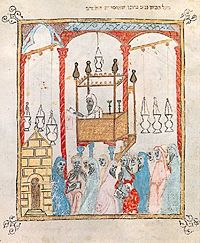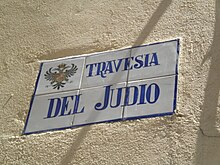Golden age of Jewish culture in Spain
| History of Al-Andalus |
|---|
|
Muslim conquest (711–732) |
|
Umayyad dynasty of Córdoba (756–1031) |
|
|
First Taifa period (1009–1110) |
|
Almoravid rule (1085–1145) |
|
Second Taifa period (1140–1203) |
|
Almohad rule (1147–1238) |
|
Third Taifa period (1232–1287) |
|
Emirate of Granada (1232–1492) |
| Related articles |
| Part of a series on |
| Jews and Judaism |
|---|
The golden age of Jewish culture in Spain, which coincided with the Middle Ages in Europe, was a period of Muslim rule during which, intermittently, Jews were generally accepted in society and Jewish religious, cultural, and economic life flourished.
The nature and length of this "Golden Age" has been debated, as there were at least three periods during which non-Muslims were oppressed. A few scholars give the start of the Golden Age as 711–718, the
Historiography and nature of Golden Age

Having invaded southern Spain and coming to rule in a matter of seven years, Islamic rulers were confronted with many questions relating to the implementation of Islamic rule of a non-Islamic society. The coexistence of Muslims, Jews, and Christians during this time is revered by many writers. Al-Andalus was a key center of Jewish life during the early Middle Ages.
Bernard Lewis takes issue with this view, calling it ahistorical and exaggerated. He argues that Islam traditionally did not offer equality or even pretend that it did and argues that it would have been both a "theological as well as a logical absurdity."[2] However, he also states:
Generally, the Jewish people were allowed to practice their religion and live according to the laws and scriptures of their community. Furthermore, the restrictions to which they were subject were social and symbolic rather than tangible and practical in character. That is to say, these regulations served to define the relationship between the two communities, and not to oppress the Jewish population.[2]
Mark R. Cohen, Professor of Near Eastern Studies at Princeton University, in his Under Crescent and Cross, calls the idealized interfaith utopia a "myth" that was first promulgated by Jewish historians such as Heinrich Graetz in the 19th century as a rebuke to Christian countries for their treatment of Jews.[3] This myth was met with the "counter-myth" of the "neo-lachrymose conception of Jewish-Arab history" by Bat Ye'or and others,[3] which also "cannot be maintained in the light of historical reality".[4]
Birth of the Golden Age
Prior to 589, the Jewish population of Spain was tolerated by its
A period of tolerance dawned for the Jews of the Iberian Peninsula. Their number was considerably augmented by immigration from North Africa in the wake of the Muslim conquest.[citation needed] Immigrants from North Africa and the Middle East bolstered the Jewish population and made Muslim Spain probably the largest centre of contemporary Jews. Especially after 912, during the reign of Abd al-Rahman III and his son, Al-Hakam II, the Jews prospered culturally, and some notable figures held high posts in the Caliphate of Córdoba. Jewish philosophers, mathematicians, astronomers, poets and rabbinical scholars composed highly-rich cultural and scientific work. Many devoted themselves to the study of the sciences and philosophy, composing many of the most valuable texts of Jewish philosophy. Jews took part in the overall prosperity of Muslim Al-Andalus. Jewish economic expansion was unparallelled. In Toledo, after the Christian reconquest in 1085, Jews were involved in translating Arabic texts to the romance languages in the so-called Toledo School of Translators, as they had been previously in translating Greek and Hebrew texts to Arabic. Jews also contributed to botany, geography, medicine, mathematics, poetry and philosophy.[6]
'Abd al-Rahman's court physician and minister was
It was a time of partial Jewish autonomy. As "
Comparing the treatment of Jews in the
Other authors criticize the modern notion of Al-Andalus being a tolerant society of equal opportunities for all religious groups as a "myth".
Dear brothers, because of our many sins Hashem has cast us among this nation, the Arabs, who are treating us badly. They pass laws designed to cause us distress and make us despised.... Never has there been a nation that hated, humiliated and loathed us as much as this one.[12]
End of the Golden Age
With the death of Al-Hakam II in 976, the caliphate began to dissolve, and the position of the Jews became more precarious under the various smaller kingdoms.[
Beginning in 1090, the situation deteriorated further with the invasion of the
During the reign of the Berber dynasties, many Jewish and even Muslim scholars left the Muslim-controlled portion of Iberia for the city of Toledo, which had been reconquered in 1085 by Christian forces.
The major Jewish presence in Iberia continued until the Jews were forced to leave or to convert to Christianity in the Alhambra Decree of 1492 and a similar decree by Portugal in 1496.

Notable figures
- Muslim conquest of Hispania
- Abu al-Fadl ibn Hasdai, philosopher, vizier at Taifa of Zaragoza
- Joseph ibn Hasdai, poet, father of Abu al-Fadl ibn Hasdai
- Yekutiel ben Isaac ibn Hassan, poet, talmudist and vizier at Taifa of Zaragoza, fell from favor, executed.
- Almohades.
- Ibrahim ibn Yaqub, traveller, probably a merchant.
- Alfonso VI of Castile
- Bahya ibn Paquda, philosopher and author of Chovot HaLevavot
- Jewish Encyclopedia, "a convert to Judaism ... [who]... went to Córdoba, where he is said to have endeavored to win proselytes for Judaism from among the Spanish Christians."
- Dunash ben Labrat (920–990), poet
- Isaac Albalia, astronomer and rabbi at Granada
- Jehiel ben Asher, poet
- Joseph ibn Migash, diplomat for Granada
- Maimonides, also known by the acronym 'Rambam', author of Mishnah Torah, Guide to the Perplexed, and commentator on the Mishnah, rabbi, scholar, physician, and philosopher
- Menahem ben Saruq, philologist
- Nachmanides, also referred to by the acronym Ramban, scholar, rabbi, philosopher, physician, kabbalist, and biblical commentator.
- Solomon ibn Gabirol, poet and philosopher
- Moses ben Enoch, rabbi and Talmudic scholar
- Yehuda Halevi, poet and philosopher
- Pedro I "the Cruel" of Castile
- Abraham ibn Ezra, rabbi and poet
- Moses ibn Ezra, philosopher and poet
- Benjamin of Tudela, traveler and explorer
- Samuel ibn Naghrillah, king's minister at Taifa of Granada and poet
- Joseph ibn Naghrillah, king's minister, son of Samuel ibn Naghrillah
- Hasdai ibn Shaprut, royal physician and statesman
- Judah ben Saul ibn Tibbon, translator and physician
- Joseph ibn Tzaddik, rabbi, poet and philosopher.
- Abraham ibn Daud, astronomer, historian, and philosopher. He is sometimes known by the abbreviation Rabad I or Ravad I.
See also
- Al-Andalus
- History of the Jews in Poland - Between c. 1025 – c. 1700 AD, called Paradisus Judaeorum (Latin for "Paradise of the Jews")
- History of the Jews in Portugal
- History of the Jews in Spain
- History of Portugal
- History of Spain
- Judeo-Islamic philosophies (800–1400)
- La Convivencia
- Reconquista
- Sephardim under Islam
- Spanish Inquisition and repression of the Jews
- Timeline of Portuguese history
- Timeline of the Muslim presence in the Iberian Peninsula
Notes
- ^ "Press Release: The Ornament of the World by María Rosa Menocal". August 28, 2005. Archived from the original on 2005-08-28.
- ^ a b Lewis, Bernard W (1984). The Jews of Islam
- ^ ISBN 0-691-01082-X.
- JSTOR 1455066.
- Jewish Encyclopedia
- ^ a b Sephardim by Rebecca Weiner.
- ISBN 0-7818-1015-9, p.73
- ISBN 0-691-01082-X, retrieved 2010-04-10
- ISBN 0-691-01082-X, retrieved 2010-04-10
- ISBN 0-691-01082-X, retrieved 2010-04-10
- ^ a b Darío Fernández-Morera: "The Myth of the Andalusian Paradise", The Intercollegiate Review, Fall 2006, pp. 23–31
- ISBN 0-9626226-3-X, p. 58
- Jewish Encyclopedia. 1906 ed.
References
- Esperanza Alfonso, Islamic culture through Jewish eyes : al-Andalus from the tenth to twelfth century, 2007 ISBN 978-0-415-43732-5
- Mark Cohen, Under Crescent and Cross: The Jews in the Middle Ages 1995 ISBN 0-691-01082-X
- Joel Kraemer, "Comparing Crescent and Cross," The Journal of Religion, Vol. 77, No. 3. (Jul., 1997), pp. 449–454. (Book review)
- "The Myth of the Andalusian Paradise" by Darío Fernández-Morera – critique of view of Al-Andalus as tolerant society
External links
- Jewish Encyclopedia article on Spain
- Excerpt from Farewell Espana: The World of the Sephardim Remembered by Howard M. Sachar, at MyJewishLearning
- The Musical Legacy of Al-Andalus an interview between Banning Eyre (Afropop Worldwide) and Dwight Reynolds, Associate Professor in the Department of Religious Studies, Director of the Center for Middle East Studies, and Chair of Islamic and Near Eastern Studies at the University of California, Santa Barbara
- Medieval Hebrew Poetry
- The Sephardim
